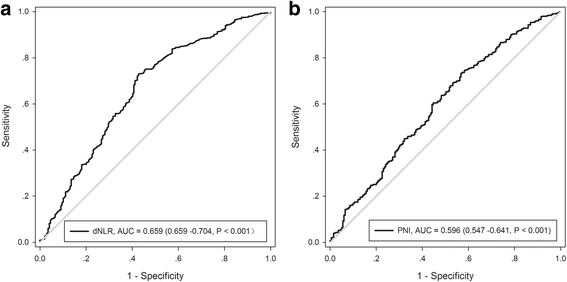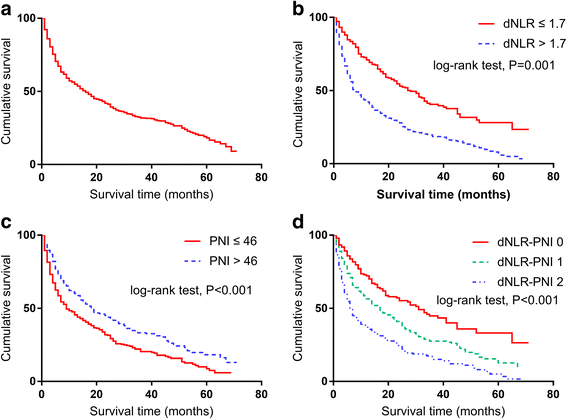A novel combined systemic inflammation-based score can predict survival of intermediate-to-advanced hepatocellular carcinoma patients undergoing transarterial chemoembolization
- PMID: 29466970
- PMCID: PMC5822668
- DOI: 10.1186/s12885-018-4121-3
A novel combined systemic inflammation-based score can predict survival of intermediate-to-advanced hepatocellular carcinoma patients undergoing transarterial chemoembolization
Abstract
Background: There is currently limited information regarding the prognostic ability of the dNLR-PNI (the combination of the derived neutrophil-to-lymphocyte ratio [dNLR] and prognostic nutritional index [PNI]) for hepatocellular carcinoma (HCC). This study aimed to assess the predictive ability of the dNLR-PNI in patients with intermediate-to-advanced HCC after transarterial chemoembolization (TACE).
Methods: A total of 761 HCC patients were enrolled in the study. The dNLR-PNI was retrospectively calculated in these patients, as follows: patients with both an elevated dNLR and a decreased PNI, as determined using the cutoffs obtained from receiver operating characteristic curve analysis, were allocated a score of 2, while patients showing one or neither of these alterations were allocated a score of 1 or 0, respectively.
Results: During the follow-up period, 562 patients died. Multivariate analysis suggested that elevated total bilirubin, Barcelona Clinic Liver Cancer C stage, repeated TACE, and dNLR-PNI were independently associated with unsatisfactory overall survival. The median survival times of patients with a dNLR-PNI of 0, 1, and 2 were 31.0 (95% confidence interval [CI] 22.5-39.5), 16.0 (95% CI 12.2-19.7) and 6.0 (95% CI 4.8-7.2) months, respectively (P < 0.001).
Conclusions: The dNLR-PNI can predict the survival outcomes of intermediate-to-advanced HCC patients undergoing TACE, and should be further evaluated as a prognostic marker for who are to undergo TACE treatment.
Keywords: Derived neutrophil-to-lymphocyte ratio (dNLR); Hepatocellular carcinoma (HCC); Prognostic nutritional index (PNI); Systemic inflammation; Transarterial chemoembolization (TACE).
Conflict of interest statement
Ethics approval and consent to participate
This study was approved by the Institutional Review Board (IRB) of the West China Hospital, Sichuan University. Informed written consent was obtained from all individual participants included in the study. All the methods used in this study were carried out according to the approved guidelines.
Consent for publication
Not applicable.
Competing interests
The authors declare that they have no competing interests.
Publisher’s Note
Springer Nature remains neutral with regard to jurisdictional claims in published maps and institutional affiliations.
Figures



Similar articles
-
Inflammation scores predict the survival of patients with hepatocellular carcinoma who were treated with transarterial chemoembolization and recombinant human type-5 adenovirus H101.PLoS One. 2017 Mar 29;12(3):e0174769. doi: 10.1371/journal.pone.0174769. eCollection 2017. PLoS One. 2017. PMID: 28355305 Free PMC article.
-
Neutrophil-lymphocyte Ratio Plus Prognostic Nutritional Index Predicts the Outcomes of Patients with Unresectable Hepatocellular Carcinoma After Transarterial Chemoembolization.Sci Rep. 2017 Oct 24;7(1):13873. doi: 10.1038/s41598-017-13239-w. Sci Rep. 2017. PMID: 29066730 Free PMC article.
-
Inflammation scores predict survival for hepatitis B virus-related hepatocellular carcinoma patients after transarterial chemoembolization.World J Gastroenterol. 2015 May 14;21(18):5582-90. doi: 10.3748/wjg.v21.i18.5582. World J Gastroenterol. 2015. PMID: 25987783 Free PMC article.
-
Transarterial chemoembolization versus hepatic resection in hepatocellular carcinoma treatment: a meta-analysis.Drug Des Devel Ther. 2015 Aug 10;9:4431-40. doi: 10.2147/DDDT.S86629. eCollection 2015. Drug Des Devel Ther. 2015. PMID: 26309396 Free PMC article. Review.
-
Transarterial chemoembolization in hepatocellular carcinoma treatment: Barcelona clinic liver cancer staging system.World J Gastroenterol. 2015 Sep 28;21(36):10327-35. doi: 10.3748/wjg.v21.i36.10327. World J Gastroenterol. 2015. PMID: 26420959 Free PMC article. Review.
Cited by
-
A novel preoperative inflammation score system established for postoperative prognosis predicting of intrahepatic cholangiocarcinoma.BMC Cancer. 2023 Feb 24;23(1):188. doi: 10.1186/s12885-023-10668-x. BMC Cancer. 2023. PMID: 36829168 Free PMC article.
-
Refining Prognosis in Chemoembolization for Hepatocellular Carcinoma: Immunonutrition and Liver Function.Cancers (Basel). 2021 Aug 5;13(16):3961. doi: 10.3390/cancers13163961. Cancers (Basel). 2021. PMID: 34439116 Free PMC article.
-
Complex interaction networks of cytokines after transarterial chemotherapy in patients with hepatocellular carcinoma.PLoS One. 2019 Nov 21;14(11):e0224318. doi: 10.1371/journal.pone.0224318. eCollection 2019. PLoS One. 2019. PMID: 31751357 Free PMC article.
-
The potential of high-order features of routine blood test in predicting the prognosis of non-small cell lung cancer.BMC Cancer. 2023 Jun 1;23(1):496. doi: 10.1186/s12885-023-10990-4. BMC Cancer. 2023. PMID: 37264319 Free PMC article. Review.
-
Prognostic Significance of Preoperative Controlling Nutritional Status Score in Patients Who Underwent Hepatic Resection for Hepatocellular Carcinoma.J Liver Cancer. 2020 Sep;20(2):106-112. doi: 10.17998/jlc.20.2.106. Epub 2020 Sep 30. J Liver Cancer. 2020. PMID: 37384320 Free PMC article. Review.
References
-
- Wood G, Grenader T, Nash S, Adams R, Kaplan R, Fisher D, Maughan T, Bridgewater J. Derived neutrophil to lymphocyte ratio as a prognostic factor in patients with advanced colorectal cancer according to RAS and BRAF status: a post-hoc analysis of the MRC COIN study. Anti-Cancer Drugs. 2017;28(5):546–50. - PMC - PubMed
-
- Hu H, Yao X, Xie X, Wu X, Zheng C, Xia W, Ma S. Prognostic value of preoperative NLR, dNLR, PLR and CRP in surgical renal cell carcinoma patients. World J Urol. 2017;35(2):261–70. - PubMed
Publication types
MeSH terms
Grants and funding
LinkOut - more resources
Full Text Sources
Other Literature Sources
Medical
Miscellaneous

